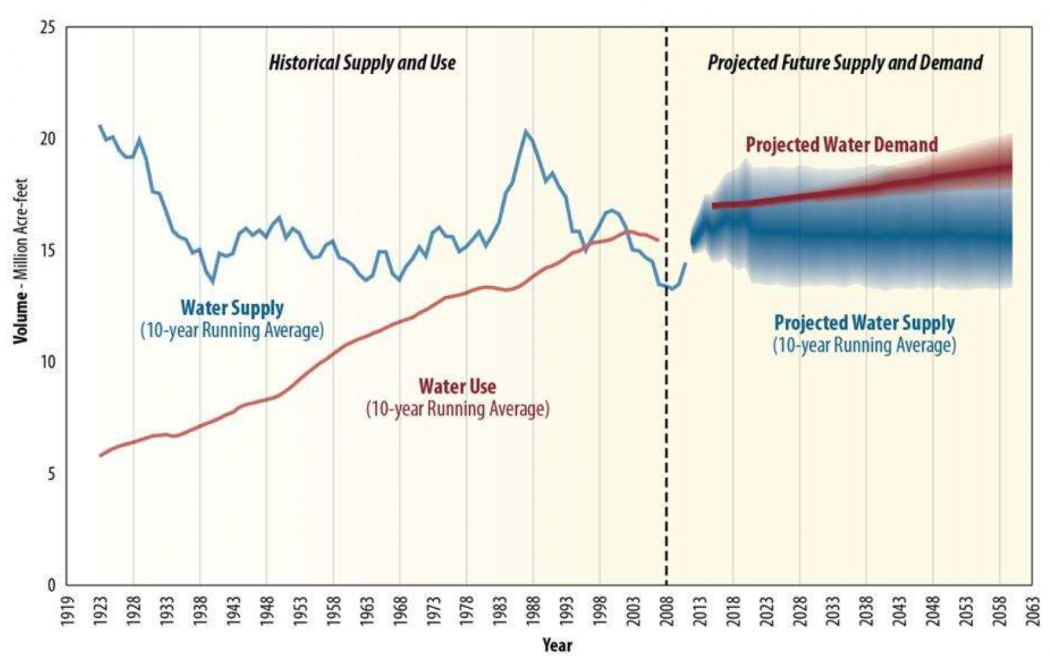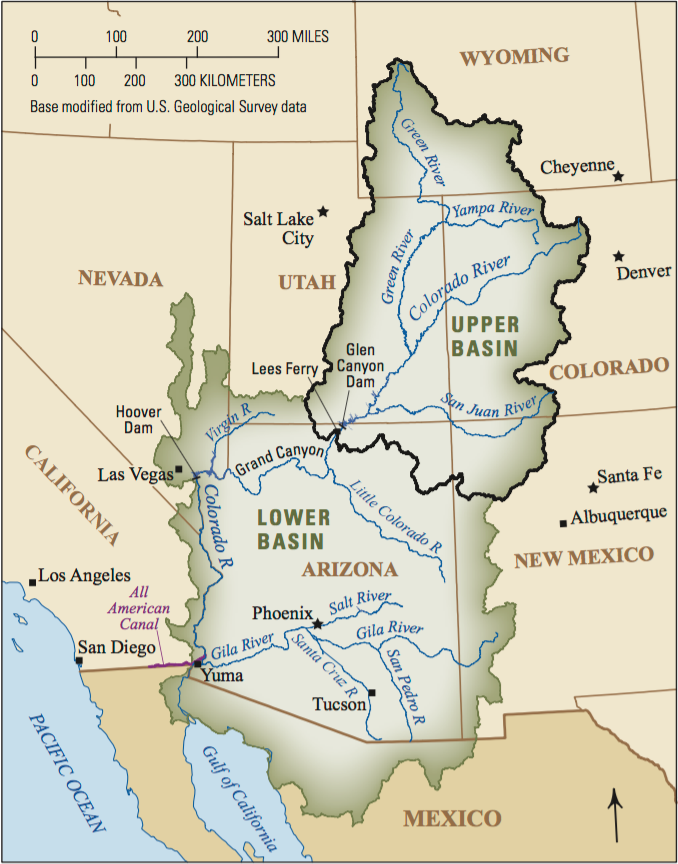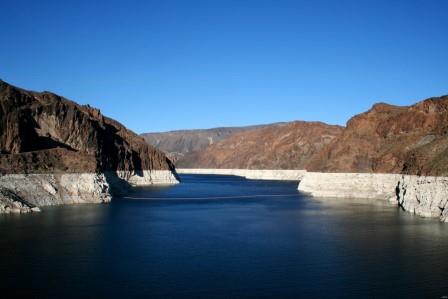Colorado River: “Lifeline of the Southwest” Suffering Effects of Economic Growth and Climate Change
by Haley Demircan
The Colorado River, also known as the “Lifeline of the Southwest,” spreads along 1,450 miles (2,330 kilometers), from northern Colorado to the Gulf of California in northwestern Mexico. This legendary river provides water for 40 million people in cities such as Denver, Phoenix, Los Angeles, Las Vegas and San Diego, as well as millions of acres of vital farmland. Seven states rely on the Colorado River as a primary source of water. But as economic growth and climate change ensue, there is major cause for concern regarding depletion and the impacts of climate change in the Colorado River basin.
Whether residents of the Southwest are using water from the river or groundwater, they are withdrawing the region’s most vital resource much faster than it can be replenished. In other words, the Southwest’s water-use challenges constitute a textbook case of a not-so-steady state economy.
The Effects of Climate Change
Over the past century, regional temperatures have risen 1.4 degrees Celsius and water usage has increased, both of which are a function of a growing, environmentally-destructive GDP. Researchers Chris Milly and Krista A. Dunne at the United States Geological Survey (USGS) published a study in March 2020 using a hydrologic model and historical observations to demonstrate that the decrease in water flowing through the river is due largely to the evapotranspiration associated with climate change.
Global warming drastically affects the snowpack that feeds the river. As temperatures in the region rise, more winter precipitation falls as rain rather than snow. Snow cover declines, causing the land to become exposed and dry. Without this snow cover, less energy from the sun is able to be reflected back through the atmosphere into space. Instead, it becomes trapped and warms the surface of the earth. Furthermore, plants need more water when temperatures rise. Just in the last century, waterflow from the Colorado River dropped 20 percent, and half of that percentage is from climate change. This reduction of water has left the two largest reservoirs in the nation, Lake Mead and Lake Powell, which were completely full in 2000, almost half empty. From 2000 to 2004, both had lost enough water to supply California with five times its Colorado River water.
With further global warming, Milly and Dunne estimate that the river will be depleted another 14-26 percent by 2050. They stated that more than half of this depletion is attributable to higher temperatures. As this trend in increased temperatures continues, the risk of severe water shortages for the millions of people who rely on the water from the Colorado River will grow.
The higher end of the percentage of depletion would mean a loss of about 1.5 million acre-feet of water—or 326,000 gallons of water—which is enough water to cover an acre of land about one foot deep. With temperatures on the rise and rainfall and snowpack declining, it is impossible to keep up with the water demand. In an interview with CNN, Brad Udall, a climate scientist at Colorado State University, warned, “Without this river, American cities in the Southwest would dry up and blow away.”
The Drought Contingency Plan
With the 19-year drought affecting the Colorado River basin, all seven basin states had to come up with a plan. In an effort to keep the levels of the two major reservoirs from becoming critically low, they created the drought contingency plan (DCP). All seven states signed the DCP for the Upper and the Lower Colorado River basins. The plan is actually a set of specialized plans unique to each state and designed to help stabilize the river system and reduce the risk of reservoirs falling to critically low levels.
The Arizona drought contingency plan goes into effect when levels in Lake Mead reach 1,090 MSL (mean sea level). Currently, Lake Mead is 1,085 MSL. Arizona is only allotted 37.3 percent of the Colorado River’s lower basin water, and the state will receive a drastic decrease in water resource as the DCP and cutbacks are managed, from 2.80 million acre-feet per year to just over a million acre-feet per year.
Ground Water Depletion, Farmland Abandonment, and Economic Impacts
In an effort to source water elsewhere, Arizona is now relying on ground water aquifers, which is not a viable solution for the future. These aquifers provide corporate farms the ability to grow as much food as possible in a short time frame. Using ground water in this way depletes the underground, fresh water much too quickly. Water depletion in Arizona has caused several issues in the past, such as land abandonment, earth cracking/collapse, and major dust storms.

Water supply and demand for the Colorado Rover. (March 2016 Report by U.S. Bureau of Reclamation)
In Pinal county, Arizona, farmers are experiencing a lack of water resources. With the new DCP, farmers have lost two-thirds of the irrigation water they had been receiving from the Colorado River. They are now relying on groundwater; however, drilling and pumping groundwater is costly, and many farmers cannot afford the large increase in the cost of water for their farmlands. Ashley Hullinger, a research analyst from the University of Arizona, conducted a water loss study specifically for Pinal Country, and she found that there could be enormous economic repercussions if ground water depletion continues at this rate.
With the loss of 300,000-acre feet of water, the study found that there would be:
- $63.5 million to $66.7 million lost in gross farm-gate sales (this accounts for 7 percent)
- $94 million to $104 million lost in total county sales (farm and non-farm sales)
- $31.7 million to $35 million lost in county value added (this includes net farm income, profits in other industries, employee compensation and tax revenues)
- 240 to 480 full-time and part-time jobs lost
Depleting water from underground aquifers at high rates provides a small solution to the large cut in the Colorado River water allocation; however, there are severe consequences to the land as well as the economy.
Where Do We Go from Here?
With temperatures on the rise due to climate change, there is no doubt that water depletion will occur. The next steps in the DCP are critical in reducing the risk of further shortages. One long-term goal is for reservoirs like Lake Mead and Lake Powell to replenish and hopefully allow for the water flow to increase in the Colorado River. Scientist like Udall, believe that the only way to save the Colorado River is by addressing what he considers the root cause of the problem—climate change. We might add an even deeper root: the GDP growth that drives greenhouse gas emissions and climate change.
“The science is crystal clear—we must reduce greenhouse gas emissions immediately,” he says. “We now have the technologies, the policies and favorable economics to accomplish greenhouse gas reductions. What we lack is the will.”
We’re not so sure about the “policies and favorable economics” part. While the microeconomics of installing renewable energy facilities may be more favorable, we still have pro-growth policies that ensure not only more renewable energy technology, but dipping further into the wells and deposits of fossil fuels.

Haley Demircan is CASSE’s fall journalism intern.





Growing population and decreasing water means we can if we want to be sustainable only if we reduce population
Quick edit of grammar needed so that conversions are correct: “The higher end of the percentage of depletion would mean a loss of about 1.5 million acre-feet of water—or 326,000 gallons of water—which is enough water to cover an acre of land about one foot deep.”
1 a.f. = 326,000 gal. 1.5 million a.f = something larger. :)
Thank you for the superb article. Great to see reference to Brad Udall, who I assume is from the Udall Foundation.
Stewart Udall was a real hero. His voice is missed, but good to see that the Udalls persist.